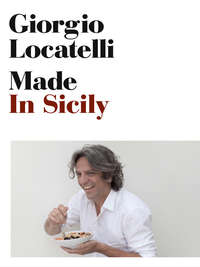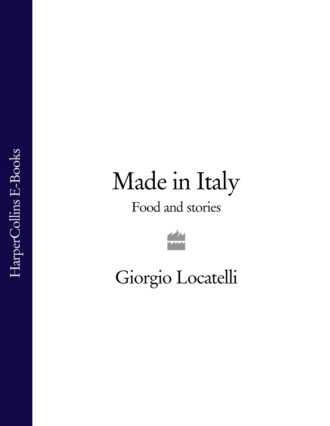
Полная версия
Made in Italy: Food and Stories
In 1980 a controlled denomination of origin for the vinegar was set up, and by law, for a vinegar to be called aceto balsamico tradizionale, it has to be produced according to these methods and approved by the Consortium of Producers of Traditional Balsamic Vinegar (Consorzio fra Produttori di Aceto Balsamico Tradizionale di Reggio Emilia). If you are a producer, you must send your vinegar to them; they taste it blind and, if it is good enough quality, and meets all the requirements, they bottle it in their special tulip-shaped bottles. They then mark it with different coloured stamps: red for up to 50 years, silver for a minimum of 50 years, and gold for a minimum of 75 years. Production of this balsamic vinegar is very limited, and for some of the people who supply their vinegar to the consorzio it is almost more of a hobby than a business: some will only make 100 or so bottles a year. We are talking about vinegars that cost up to £100 a bottle, but when you taste the real thing, the experience is extraordinary.
There is another category of balsamic vinegar that is either produced outside the designated region of Reggio Emilia, and so cannot be called ‘tradizionale’, or is made by people who don’t want to deal with the consorzio – maybe they have such a small production that it isn’t worth their while. Or sometimes, producers of ‘tradizionale’ also make other, high quality vinegars that haven’t been aged for so long. Such vinegars must be labelled condimento balsamic vinegar and although they can’t be called ‘tradizionale’ they are made using identical methods, so they can be fantastic quality, and are usually cheaper. I have stayed near Modena and seen people go to the local producers with their own bottles, which the guys fill up for them – and it is beautiful vinegar – but, of course, you have to rely on local knowledge to find out where to go.
The big difficulty is over bottles that are just labelled ‘aceto balsamico di Modena’. Ever since the world ‘discovered’ balsamic vinegar there has been a huge industrial production, which bears no relation to the true artisan product. The legal definition of this vinegar is very loose. Much of it is only white wine vinegar with caramel added. I could make it for you in a pot in the kitchen in 15 minutes – but what an insult to the people who have been making beautiful vinegar in the proper way for hundreds of years. Some of it, though, has been made in a way that is similar to the traditional methods, using at least some cooked grape must, and aged in wood for at least a few years. So how to tell? Often ‘aceto balsamico’ vinegar comes in elegant bottles, sealed with wax, with beautiful labels that suggest ancient traditions, but it is important not to be distracted by the lyrical descriptions that the producers tend to use, and go straight to the ingredients list. The first thing to be listed should be the must of the grape, and there should be no mention of caramel, or any added flavourings. Look for a vinegar that says it has been aged in wooden barrels – as ‘aged in wood’ can sometimes mean wood chips have been added as the vinegar ages.
There is yet another type of vinegar, called vincotto (‘cooked wine’), which is similar to balsamic, made in a serious way but without the ageing and complexity. They say vincotto has its roots in the old Roman tradition of pressing grapes that had been partly dried, then fermenting them to make raisin wine. It became something farmers would make as a sweet dressing for festivals, or as a tonic, but is now being produced commercially, using the Trebbiano grape in the North. As you move further south it is more likely to be made with the Negroamaro and the Black Malvasia, which are left to dry on the vine or on wooden frames before being ‘cooked’ and reduced for 24 hours. The syrup goes into small oak barrels with some of the ‘mother’ or ‘starter’ vinegar from their wine vinegar production, and it is then aged for four years.
In the kitchen at Locanda we use various different balsamic vinegars, and also sometimes vincotto, but for the table we use only the ‘tradizionale’, which we often dispense with great ceremony, using a syringe. It is very expensive but used sparingly it will last you a long time. I would say that if you can only afford to buy one bottle of it in your life, it is worth it, because only by tasting the true traditional vinegar can you begin to understand what balsamic vinegar is about. It is something I would like everyone around the world to experience, because then it can be used as a benchmark by which to judge other, less expensive, balsamic vinegars.
Almost everyone likes the taste of a true balsamic vinegar, kids especially. At one time, the only way we could get my daughter Margherita to eat a green bean salad was to toss it in balsamic vinegar. It is like a natural flavour-enhancer. Good balsamic vinegar needs to be used very simply, though, with specific ingredients. Its combination of sweetness and acidity is at its best with salty, fatty things: so a few drops are perfect with Parmesan, especially the concentrated flavour of an aged cheese. A lovely thing to serve before dinner with an aperitif is just a sliver of Parmesan on a spoon with a drop of vinegar on top. Or sometimes, when we have held parties at Locanda, we have put out half a wheel of Grana Padano cheese, which is similar to Parmesan (see page 209), so that people can pick up small pieces, drizzle over some vinegar and eat it with a glass of Prosecco. I always keep a good bottle of balsamic vinegar at home and sometimes, if I go home late at night from the kitchen, that is all I have – a big wedge of Parmesan with a little vinegar. Since both the cheese and the vinegar originate in the same region of Italy, there is an affinity there that comes with produce of the same land, and so the combination is very satisfying.
Sometimes we make agnolotti with Parmesan, tossed in a little butter, with a couple of drops of balsamic vinegar added; and I love to serve balsamic vinegar with pork belly, or with calves’ liver, in a simple sauce made with sultanas and nuts (see page 484). A little drop is amazing with plainly cooked wild salmon, and balsamic vinegar and strawberries is another famous combination.
I don’t think balsamic vinegar works with bland food. With a cheese like mozzarella, the effect is wasted, and I wouldn’t usually use it to dress a leaf salad, as it loses its impact, unless you are using strongly flavoured leaves like chicory, radicchio or rocket. And I completely disapprove of serving bread with a bowl each of oil and balsamic vinegar – oil yes, but if you dip good bread into balsamic vinegar, you ruin both things. For me it doesn’t work with complicated dishes either. If you were to spoon balsamic vinegar over an elaborate fish dish with lots of different elements, yes, it would add another level of flavour, but again it would be a waste of something special, that deserves to be treated with respect.
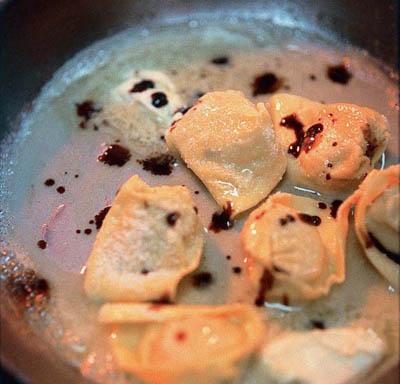
Dressings
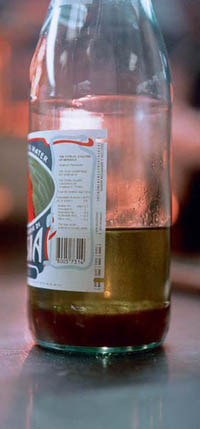
There is no real Italian equivalent for the word ‘vinaigrette’ because traditionally, when you went into a restaurant and ordered a salad, they would bring the oil and vinegar, and some salt to the table – or if you wanted oil and lemon, you would just ask for olio e limone. Nowadays, if a salad comes ready-dressed, we just borrow the French term. Or we might use the word condimento, which can mean any kind of seasoning or flavouring as well as a dressing; or even aspretto – from aspro meaning sour. We usually use this term when we create a dressing in which there is an element that we have made ourselves – such as our saffron ‘vinaigrette’, which we would call Aspretto di zafferano.
When my brother, Roberto, and I were kids, we were sometimes taken to a local restaurant where dressing the salad was considered a bit of an art. Usually we didn’t want to eat salad at all; we just wanted to watch the waiter perform his ceremony at the table. He would take a silver spoon, put some salt into it, then pour in the vinegar and let the salt dissolve in it. Then he would drizzle a line of oil into the salad bowl and pour in the seasoned vinegar at the same time, so the two met in a stream. Finally, he would put in the leaves and toss everything together in front of us.
The point is that dressing salad leaves should be done at the very last moment before serving, to preserve some crunchiness. Wash the leaves well, trying not to squeeze them, let them drain naturally in a colander, then finish off in a salad spinner. Dress the leaves very lightly so that the dressing just coats them, without drowning, and when you toss everything together, really lift up the leaves so that the dressing coats every single one.
If you are dressing a more complex salad that includes other ingredients besides leaves, think about their consistency before you add the dressing. It is only the delicate leaves that need to be dressed at the last minute, so if, for example, you are making a rocket and tomato salad, the heavier, denser tomato will need more seasoning – earlier – than the rocket. What I would do is put the tomatoes in the salad bowl with some dressing, season them and leave them for ten minutes or so to soak up the flavours and release the juices that the salt will bring out. Then, at the last minute, I would throw in the rocket and toss everything together, adding a little more vinaigrette if necessary – a lovely thing to do at the table.
I can never understand why people buy ready-made vinaigrette in a bottle when there can hardly be anything simpler than mixing together some good oil and vinegar, seasoning it with a little salt (I also add some water, just to soften the dressing), putting it into a bottle with a cork in it and storing it in the fridge. That’s it. My children make vinaigrette at home without even thinking about it. So how can commercial manufacturers tell us that what they put in a bottle is better? Some of them seem to have invented a machine that leaves the dressing in a state of permanent emulsion, which people think must be a good thing. But all you have to do to emulsify a dressing is shake your bottle of oil and vinegar.
There is, of course, no rule that says you must use olive oil for everything – not even in an Italian kitchen would we be that partisan. Sometimes we use other oils, including walnut and hazelnut, to give a different taste to a salad. Just think about your flavours before you add a very distinctive-tasting oil, so that your ingredients and your dressing complement each other and you have no violent clashes.
Giorgio’s vinaigrette
The reason this is called Giorgio’s vinaigrette is not that I am doing anything special – millions of people around the world make exactly the same thing. It just happened that when I was at Zafferano there was a young Algerian chef who could never remember which dressing was which, because we used several in our kitchen. We would shout to him, ‘Vinaigrette!’ and he would say, ‘What does it look like?’ Eventually he stuck a label on each bottle and he called this basic vinaigrette, with oil and vinegar, ‘Giorgio’s vinaigrette’ – so the name has stuck.
I like to mix the vinegar and oil in the ratio of one part to six, but the flavour of vinaigrette is a very subjective thing and everyone has their own ideas. Personally, I don’t like to use a strong Tuscan oil, nothing too peppery and strong for vinaigrette, and you might prefer to add more or less vinegar. It also depends on the quality of the vinegar and its alcohol level. Make up some vinaigrette, taste it and adjust it as you like. The important thing to remember is that if you try it neat, it will taste more powerful than when you mix it with a salad. So, either test it with some leaves, or do what I suggest to my chefs: take a little of the dressing on a spoon, put it into your mouth, then suck it in quickly – it should be sharp enough to make you cough slightly, but not so strong that it really catches in your throat.
Buy the best quality oil and vinegar you can afford, because you can’t put in flavour that isn’t already there. And make up a big bottle, so that you use it all the time. I would be a very happy man if every British family had a bottle of Giorgio’s homemade vinaigrette in the fridge.
Put the salt into a bowl, then add the vinegar and leave for a minute so the salt dissolves.
Whisk in the olive oil and the water until the vinaigrette emulsifies and thickens.
Pour into a bottle, seal and store in the fridge, where it will keep for up to 6 months. It will separate out again into oil and vinegar, so before you use it, just shake the bottle.
Makes about 375ml
½ teaspoon sea salt
3 tablespoons red wine vinegar
300ml extra-virgin olive oil
2 tablespoons water
Aspretto di zafferano Saffron vinaigrette
Makes about 750ml
500ml white wine
150ml white wine vinegar
1 level teaspoon saffron strands
1 tablespoon caster sugar
100ml extra-virgin olive oil
Put the white wine, vinegar and saffron into a pan over a low heat and bring to the boil. Simmer until reduced by three-quarters, then remove from the heat, stir in the sugar until dissolved and leave to cool. Whisk in the oil.
Store the vinaigrette in the fridge, where it will keep for up to 6 months in a screw-topped jar or bottle – or a squeezy plastic one. Take it out of the fridge half an hour or so before you need it, and shake to emulsify before use.
Condimento allo scalogno Shallot vinaigrette
Makes about 250ml
2 banana shallots or
4 ordinary shallots
75ml red wine vinegar
150ml extra-virgin olive oil
salt and pepper
Finely chop the shallots, then put them in a bowl and season with salt and pepper.
Add the vinegar and leave to stand for 30 minutes.
Whisk in the oil and use straight away.
Condimento all’aceto balsamico Balsamic vinaigrette
Makes about 350ml
1 teaspoon salt
250ml balsamic vinegar
100ml extra-virgin olive oil
Put the salt into a bowl, then add the vinegar and leave for a minute so the salt dissolves. Whisk the oil into the vinegar.
This will keep in the fridge for up to 6 months in a screw-topped jar or bottle – or a squeezy plastic one. Take it out of the fridge half an hour or so before you need it, and shake to emulsify before use.
Olio e limone Oil and lemon dressing
Makes about 200ml
pinch of salt
3 tablespoons lemon juice
150ml extra-virgin olive oil
Put the salt into a screw-topped bottle or jar, then add the lemon juice and leave for a minute so the salt dissolves.
Add the oil, put the top on, and shake well to emulsify. It is best to use this dressing immediately.
Maionese Mayonnaise
Makes about 600ml
1 egg yolk
pinch of salt
1 teaspoon English mustard
2 tablespoons white wine vinegar
500ml vegetable oil
juice of ½ lemon
Put the egg yolk in a mixing bowl and break it up a bit.
Add the salt and mustard with half of the vinegar and whisk together for a couple of minutes (this is very important as it helps the mayonnaise to emulsify once you start to put in the oil).
Slowly start to add the oil, whisking continuously, until it is completely incorporated. If it starts to get too thick, add the rest of the vinegar; and if is still too thick add a tablespoon of hot water – just enough to loosen.
When the oil is completely incorporated, add the lemon juice and adjust the seasoning to your taste – add a little more vinegar or lemon juice if you like it a little more sharp.
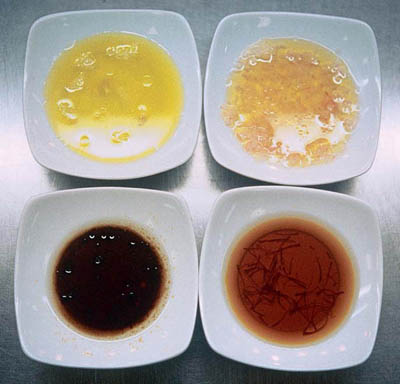
Seasoning
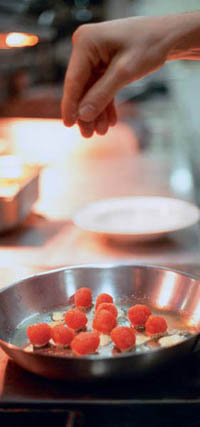
‘All about balance’
At home, when I cook something that Plaxy regularly makes, my kids often say my version tastes different – the reason, I think, is the seasoning. I was shocked the first time I saw chefs using salt in a restaurant kitchen because the proportions seemed enormous: handfuls were going into every pot, over meat, fish, vegetables. I remember going home to my grandmother and saying: ‘They use so much more salt than you.’
As a chef, you are taught to see salt in a different way. You have to think about how we taste our food; receiving different sensations in different parts of the mouth. If you under-season, you are taking away a whole layer of flavour; if you over-season, you block out all the other sensations. Salt can also help you experience sweet flavours in a more pronounced way. Heston Blumenthal of the Fat Duck in Bray does an experiment with a glass of tonic water – if you keep adding salt a little at a time, it gets to the point where it tastes sweeter; then obviously if you carry on, the saltiness takes over. At Locanda, we do a tomato ‘soup’ for a dessert with basil ice cream. When we first made it, we served it with sweet sablé biscuits, then we tried it with slightly salty biscuits, and the difference was amazing.
Seasoning is all about balance; so you must be constantly tasting and adjusting. Of course, it is also true that taste is a subjective thing, and I would never be so precious as to get angry with anyone in the restaurant who wanted to add extra seasoning to their food, as some chefs famously have. I only hope that people taste first.
These days everyone is rightly concerned about the quantity of salt that children, in particular, are eating, but most of the damage is done not when we cook fresh food, but by the salt we often unconsciously eat in processed food. Also, if you taste and season carefully as you are cooking, allowing the salt time to dissolve and do its job of flavouring properly, you will end up using far less than if you taste at the end, panic because everything is bland, and start seasoning crazily.
Most chefs have cut back the quantity of salt in cooking over the years, and looked for different ways of amplifying tastes, for example bubbling up juices and sauces in the pan, so that they reduce and thicken, and the flavour intensifies. Also, we are constantly trying to find producers and farmers who value traditional methods and believe that flavour is more important than fast-grown, perfect-looking homogenous products that will please the supermarkets. So, when you have a carefully and slowly reared, properly hung piece of meat, a terrific vegetable that has not been forced under glass, or a fish straight from the boat, you don’t need to season heavily, or you will distort the essential flavours.
On the other hand, everyone is crying, ‘salt, salt, salt!’ as if it is a demon, but we all need a certain amount of it for our bodies to function properly.
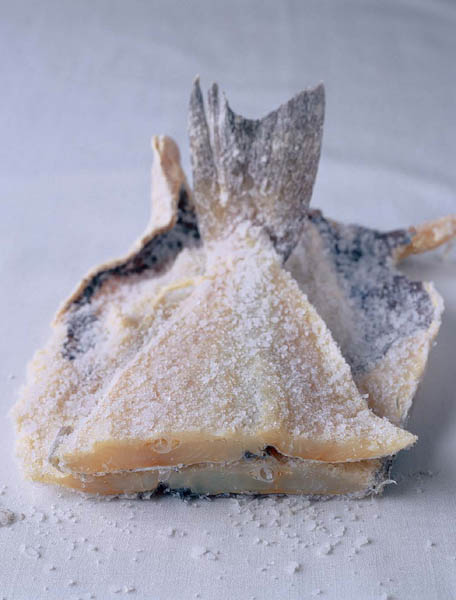
We can take a lesson from the behaviour of animals in the wild whose trails will often lead to natural sources of salt, because it is essential for them to stay alive. I remember reading about the big apes, the ones that are so human that they look like us and have a ‘wife’ and family – at certain times of the year they will head towards mountains which they know form natural rock salt and lick the salt.
Because we are so used to refrigeration, we underestimate the importance that salt has played in our civilisation and politics. As well as keeping the body healthy, and flavouring food, when it was first discovered that you could use it to extract moisture from meat or fish, and therefore cure and preserve foods so you had something to eat all year round, it must have seemed a magical thing. No wonder whole communities were built around the production and trade of something so precious. In Italy, Venezia owes much of its splendour to its position at the centre of the salt trade (along with Genova). Roads were built especially to transport salt; wars were fought over it, taxes raised on it – all of which Mark Kurlansky brings together in his brilliant book called Salt: A World History.
The first proper salt works date back to 640BC, when one of the early Roman kings, Ancus Martius, built an enclosed basin at Ostia and let in seawater, which evaporated under the sun, leaving behind sea salt. The road that the salt travelled in order to be sold was called the Via Salaria, and the soldiers who protected it were often paid in salt, which is where the word ‘salary’ comes from. If someone didn’t do his job properly he was considered ‘not worth his salt’. The word salami (pork preserved with salt) comes from the Latin ‘sal’ for salt, as does salad (it was used to describe the Roman way of adding salt to greens and herbs, perhaps to draw out bitter juices in the way that we do with aubergines, then dressing them with oil and vinegar).
We have Parma ham because people in the region needed to preserve meat, and salt could be brought in from Venezia, with payment in either money or hams. Of course, there was a massive trade in smuggling in order to avoid paying the taxes that were levied on salt. The route the smugglers used is called La Via del Sale (the road of salt) and runs all the way from the Appeninos to Liguria. Nowadays part of the route is used for a fantastic endurance motorbike race, also called La Via del Sale.
What we are talking about is natural sea or rock salt, very different from ‘table salt’, which is bleached and refined, often has chemicals added and has a harshly salty flavour. I always thought what a great job it would be to spend your days skimming off the perfect little crystals at some natural saltpan, somewhere wild and beautiful. This is the kind of salt you can pack around a piece of meat or fish for baking in the way that has been done for thousands of years. (Originally, you would have dug a pit in the ground, put in the fish or meat in its salt crust, covered it over and built a fire over the top.) As it cooks, the salt crust becomes rock hard, sealing in all the moisture and juices, and gently seasoning at the same time, but without making the cooked meat or fish taste ‘salty’.
When Thomas Keller, the inspirational chef of the French Laundry in California, came to Locanda to eat, we got talking and he told me about the way he served foie gras with five different salts, including Dead Sea Salt and Jurassic Salt. When he went back to America he sent me some of the Jurassic Salt, which is mined in Utah. It is incredible to think that it comes from a geological layer underneath that of the dinosaurs. At one time most of North America was covered in shallow sea, which evaporated over millions of years, leaving behind the salt, then in the Jurassic era volcanoes erupted around the old seabed and sealed the salt inside volcanic ash. The salt comes in a pinkish block that you have to grate, and it has a flavour that is amazing; it almost has a fizzy character to it. We sprinkled it over some carpaccio and served it with nothing else but a piece of lemon and it was beautiful.
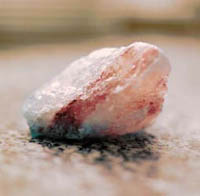
When you are seasoning, it is important to remember that salt has the function of extracting moisture as well as flavouring. You need to season meat or fish before you start to cook it, because once the outside has been sealed, your salt and pepper won’t penetrate in the same way. However, once you season a piece of meat or fish with salt, it will start to ‘sweat’ out its juices, so if you do this too far ahead of cooking it the flesh will become tougher. The trick is to season your meat or fish with salt and pepper just before you cook it – then, especially if you are cooking it over a high heat, the meat will be properly seasoned, and the salt and pepper will help form a nice ‘crust’ around the outside of the meat, while the juices will be sealed inside.





